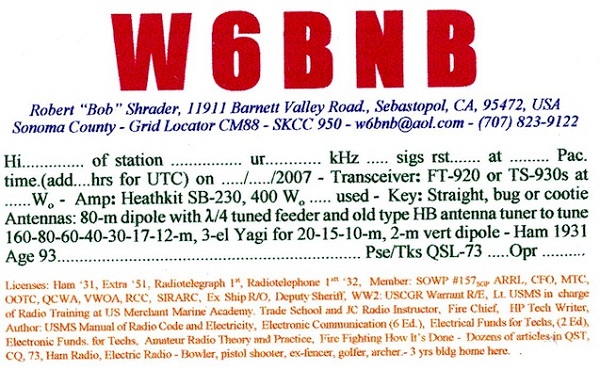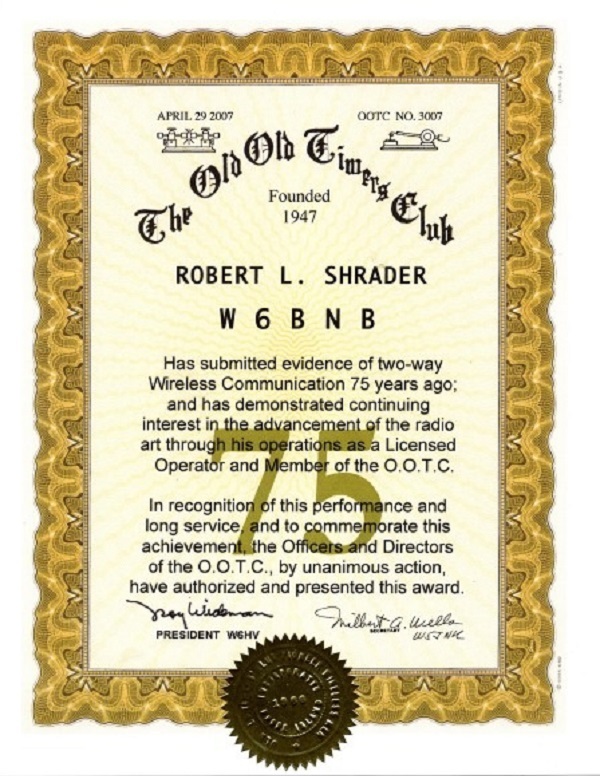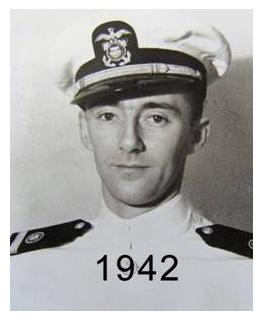
|
Robert L. 'Bob' Shrader Sebastopol, CA QCWA # 13090 |
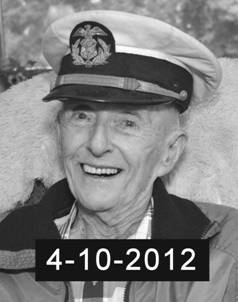
|
Robert L. (Bob) Shrader, W6BNB, author of 10 QST articles, died April 11 at age 98. He was a long-time resident of Sebastopol, California. His most recent QST article was "Using Mechanical CW Keys" in the February 2010 issue. A prolific author at an age when most settle into retirement, he also published articles in Ham Radio and CQ. He was inducted into the CQ Amateur Radio Hall of Fame in 2004.
At a young age, he was hired as a shipboard radiotelegraph officer for the Dollar Lines, and sailed around the world six times. During his long and prolific lifetime, Bob served as a deputy sheriff, radio and electronics instructor, and chief of the Freestone (CA) fire department. His textbook, Electronic Communications, was published in 1959 by McGraw-Hill.
For more information on Bob's fascinating life, see his online reminiscence.
Bob is survived by his wife Dorothy, W6ECU, a son Doug, KJ6TEJ, and daughter Patricia.
THE CAREER AND REMINISCENCES OF BOB SHRADER - W6BNB
W1TP TELEGRAPH AND SCIENTIFIC INSTRUMENT MUSEUMS: http://w1tp.com
The following accounts of the use of radios on ships in the early part of the 20th century were provided by Bob Shrader - W6BNB...
If you have any questions for him you may contact him by email at w6bnb@aol.com
BOB'S CAREER:
Bob Shrader - W6BNB obtained his amateur radio license while he was in high school. In 1932 he went to Central Trade School to obtain his commercial telegraph and phone licenses.
In 1933 he went to sea as a radio operator for Dollar Line on round- the-world trips (6 times) and then trans-Pacific on other liners (12 times) then trips to Honolulu on Matsonia and one trip on a freighter to Panama and back.
In 1939 he became deputy sheriff for Alameda County at KPDA where worked phone, CW and did some patrol work. He was in charge of radio and electricity training of deck Cadets at U.S. Merchant Marine Academy at Kings Point, L.I. He returned to the sheriff's office in 1945. In 1946 he took over teaching day and night classes at Central Trade School, which later became Laney College.
In 1959 he wrote a text book "Electronic Communication" and other electronic and electricity texts for McGraw-Hill. In 1969 he retired and moved to Sebastopol with his wife and spent 3 years building a new home. He joined the volunteer fire department, ending up as Fire Chief of the Freestone Fire Dept. He then went on to Twin Hills FD as Director. He wrote "Amateur Radio, Theory and Practice", again for McGraw-Hill, did short stints with Hewlett Packard in microwave repair in 1957, and as tech writer in 1979. In 1991 he brought out the 6th edition of E.C. And most recently, he wrote "Fire Fighting, How It's Done" for Vision Books International, which will be published in July 1997.
BOB'S EXPERIENCES AND REMINISCENCES:
Bob first wrote to me to ask me to identify a bug that he had owned for many years:
He wrote:
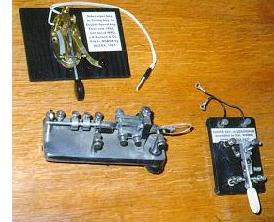 The old bug in this picture has quite a history. It is shown with my Bunnell double-speed key above and my home brew sideswiper at the right..
The old bug in this picture has quite a history. It is shown with my Bunnell double-speed key above and my home brew sideswiper at the right..
On the first trip I made as rdo op around the world, the chief op got tired of my changing his adjustments and suggested I get myself a bug of my own. When we reached New York City I spent $ 6 to buy this little bug brand new.
The round-the-world trips started in late 1933 and I used it daily until 1939 at sea, then from '39 to '46 in police radio CW, then from '46 to '69 while teaching rdo communications at a trade school/junior college, and from '69 to date on the ham bands. In 1937 while on the SS President Hoover it was used to send the SOS while the ship was being bombed by Chinese airplanes. Really a sweet feeling old friend. Hi.
I am sorry that I can't tell you the address where I purchased the bug. All I remember was that it was on the North side of Cortland Street on the West side of New York City. It was in December of 1933 during a stop-over on my first trip around the world as a Dollar Line radio operator.
We started from San Francisco and went from there to Honolulu, Kobe, Shanghai, Hong Kong, Manila, Singapore, Penang, Columbo Ceylon, Bombay, Suez, Port Said, Alexandria, Naples, Genoa, Marseilles, New York, Boston, New York, Havana, Panama Canal, LosAngeles and back home. What a trip for a 19 year old kid!
We used 2 kW spark transmitters for the medium frequencies mostly. We also had a self-excited push-pull triode 1 kW HF and MF transmitter. We used TRF receivers for HF and an IP-501 regenerative detector plus 2-stage AF receiver for MF and LF. p> In 1937, while on our way to take Americans out of Shanghai due to the Sino-Japanese war, the 635-ft luxury liner SS President Hoover was at anchor in the Yangtze River, waiting for clearance to move into the Woosung River and Shanghai. All of a sudden we heard airplanes coming and then the sound of bombs dropping in the water and on our top deck.
The skipper turned to me and said, "Well, Sparks, I guess you better send an SOS." So I went into the radio room and flipped on the "1 KW" VT (Vacuum tube) transmitter set and with my trusty old Logan Speed-x bug sent a very fast SOS. Of course we were always told to send a 1- minute transmission of 4-sec dashes followed by 1-sec spaces before sending a distress call. With the planes still overhead I decided that information was for other conditions and I just let go with my bug. I knew that the ops at the Shanghai radio stations were very good operators and my 25 or so wpm sending would be no problem to them.
We later found out that the planes were Chinese and that they thought we were the Asama Maru, a big Japanese ship that was supposed to be in the area. How they could miss the 30-foot long American flag laid out on our top deck I don't know. But is was something to remember. We were not supposed to be at war! One dead and a few injured -- so we were lucky. Those Chinese pilots were not too great as they had a sitting duck with us at anchor there in the river.
The Dollar Line 2-kW spark transmitters in use at that time had fast operating QSK keying relays. The keying circuit only required a fraction of an ampere to key the many amperes in the primary of the spark transformer. I measured the Leach keying relay coil I have here that was used with spark transmitters and it reads 225 ohms, which in series with a 250 ohm resistor was used across the regular 110-V dc line aboard most ships in those days. The heavy duty keying contacts on the bug easily handled that amount of current, about 0.25 amps. We were handling traffic at speeds up to at least 30 wpm with no trouble with our spark sets.
In your last communication you suggested that information on old time equipment might be of interest. So here is some information about transmitters that I know of first hand - and some that predated me but that I know about.
TRANSMITTERS:
The first transmitters, around the turn of the century, were open-gap spark types. The 500-cps ac was stepped up by a transformer and fed across a spark-gap in series with a primary coil which developed 1000- cps damped waves that were fed to the antenna. The resonant frequency of the antenna did most to determine the transmitting frequency. In the teens the gaps were often just open, or rotary types and made a terribly loud noise and generated a lot of ozone. In the 20s the gaps were made into many very short gaps in series, each being surrounded by copper enclosures, with mica insulators between copper holders so that each gap unit was not shorted. These were called quenched gaps because the noise was quenched, and so was the ozone.
Shipboard spark transmitters were usually built behind vertical bakelite panels sitting on top of the operating tables. I remember one ship's mate coming into the radio room to shoot the bull with us. He made himself very comfortable sitting on the desk top and leaning back against the spark transmitter while we talked. His rear end was pushed up against the 2-ft wide quenched gaps which stuck out in front of the panel. When the ship was called, the operator on watch forgot about the mate and switched on the spark transmitter to answer. Boy did that mate jump! A 2-kW spark transmitter, which was very loosely coupled to the antenna to provide a not-to-wide signal (30 kHz at 100 miles?), could be used for trans-Pacific communications with no trouble under reasonable conditions. They can operate on all frequencies.
Spark transmitters were no longer used by U.S. ships after WW2, although some foreign ships used them for many years after that.
In the teens the arc transmitter was developed. A dc electric arc has negative resistance across it. So, if an antenna-to-ground circuit is interrupted by putting an electric arc in series with it, the negative resistance of the arc makes up for the positive resistance of the antenna circuit wire and the radiation losses, so the antenna oscillates at its fundamental 1/4-wave frequency. These rigs put out nice clean unmodulated CW on lower frequencies. Most of them used back-shunt keying, meaning that when the key was down the signal was transmitted by the antenna at its resonant frequency. When the key was up the keying relay shunted the arc circuit to an LC dummy load tuned to some other far removed frequency so the operator could copy the station who was answering on the transmitting frequency.
The arc transmitter was going all of the time but only on the desired frequency when the key was down. These rigs were very good on higher wavelengths but down on the ship calling and distress frequency of 600 meters (500 kHz to youngsters) they sounded pretty burbly. Because the arc worked best in an alcohol or hydrogen atmosphere, when they were first struck by their operator, if there happened to any oxygen in the sealed arc chamber the result was an explosion and the top would swing back on its hinges. This threw out a sooty whiff that would show up as a black stripe across the chest of the operators white uniform. They did not like that. Arcs were not used at sea after the '30s although hundreds-of-kilowatt rigs ashore communicated during WW2 over long distances on frequencies lower than 50 kHz.
The only arc transmitter that I used was the one we had set up in our radio class room at the old Central Trade School in 1932. We had it explode.
We also gave local commercial stations KPH and KFS some QRM when we would key it. But they knew the instructor so did nothing about it.
I have worked other stations on 500 kHz who were using arcs.
There was something else I forgot to tell you about in the way of old time tranmitters, the ones that used VTs.
In the late teens vacuum tubes became large enough to be used in transmitters. By the mid-'20s an old spark transmitter was converted into a "P-8" transmitter. Two push-pull 204A triodes were installed in place of the quenched gaps in a self-rectified Colpitts oscillator circuit. It put out something over 100 W in the MF range. Later MOPA rigs were at sea with a Master Oscillator and a Power Amplifier. Power outputs were becoming greater. By the '30s Globe Wireless (not to be confused with the present Globe Wireless) had a 2-Gammatron triode self-rectified push-pull oscillator tranmitter for both HF and MF operations. By use of a Variac on the front panel the power output could be adjusted from a watt or two up to 1 kW. Its 500-Hz ac power source was doubled to a 1000-Hz output modulated CW, a really nice signal to copy. Also, it was over 100% modulated so it was pretty broad. This was advantageous because the receivers at that time drifted badly as did the transmitter. By this time LF operations had dropped off to almost nil at sea.
RECEIVERS:
Original receivers at sea were either solid-state crystals or other simple diode type rectifiers. They could only be used to pick up modulated signals so they were usable with spark signals and MCW transmissions. In fact up to this date SOS and other emergency sets are supposed to use MCW to assure the signals are audible on any kind of receiver, should they be tuned to zero-beat with the transmitter.
In the teens triode oscillators were beginning to be used as the detectors. Besides operating as a diode in the grid circuit they also provided amplification in the plate circuits. This was the well known "regenerative detector" system. In oscillation it would beat against incoming signals providing a beat-tone to be heard in the earphones. With a 2-stage amplifier it could provide enough amplification for loudspeaker operation.
Being an oscillator and coupled to an antenna it also radiated a constant CW signal that could be heard for several miles. At sea all operators monitored the distress frequency of 500 kHz constantly. As result, any time a ship would pass by within a few miles its weak whistle signal would be heard. Once when sending in an arrival message to the coastal station at Colombo, Ceylon I keyed my receiver to send the message. The operator at the dock station would not believe me. When I turned on my 2-kW spark set and repeated the message he believed me! His ears must still be ringing. During WW2 the German subs would monitor 500 kHz and when they heard the weak whistles they would find the ship and sink it. With an RF amplifier in front of the detector this was not a problem. That was the demise of the regenerative detector at sea. In the mid-'30s superhets began to find their way into ship communications.
73 W6BNB Bob
Bob started a sideswiper net on 80M in California, it was still going on in the 1980s when I came across it. I joined in when sailing upstream along the California coast headed for Alaska. I checked in using a Vibroplex, and I probably mistakenly thought they were irritated that I did so, but in reality, no one cared, they were just delighted that I checked in, cootie senders are like that I found out, but I had a chance to listen to some awesome cootie operators (all of whom I've forgotten names, calls, except Bob who was legendary and very generous with his time. He wrote "Electronic Communication" which was the bible especially for those taking the Telegraph FCC element 5 (telegraph procedure) and 6 (radiotelegraph circuits and theory), in fact his edition 1 and 2 carried information about Spark and Arc - both of which Bob had learned on and used on his trips with Dollar Line - which was the predecessor of American President Line.
From https://www.gjenvick.com/OceanTravel/SteamshipLines/DollarSteamshipLine.html
Dollar Line continued expanding its business in the late 1920s, buying five more "535 President Type" ships in 1926. In that year, Dollar Line carried over 45,000 passengers and had gross revenue of $6 million. Dollar encouraged others to invest in Asia with his booklet, "Have You Investigated the Oriental Market for Your Product?", helping to open up Asia to 20th-century industry. The Merchant Marine Act of 1928 (also known as the JonesâWhite act) also helped Dollar Line, allowing it to sign a lucrative new mail contract and requiring it to build new ships to meet demand.
On May 16, 1932, Robert Dollar died at the age of 88 and was succeeded by his son, Robert Stanley Dollar. Following Robert senior's death, the company began a steady decline. In 1938. American Mail Line became American President Lines.
We used to have a brief history of Bob's old sideswiper net but it's gone missing from the web updates.
Bob was also active in the Society of Wireless Pioneers "Intercontinental" net which was run by Hank W1HRQ who had Âtwo 120 foot towers and strung 130 feet of wire between them. He showed me what a great signal can be had if you just spend the attention and money on a dipole like you usually do when you put up a beam. How true.
Hank W1HRQ taught electronics for RCA and he was outstanding say the many R/O's who took his class, no elitism of "the educated" was his, which is fabulous and a wonderful refreshment from the constant elitism we find today where people who didn't pursue degrees are marginalized. Hank sent with a Yaesu FT-101 and he inserted a 1 mfd capacitor across the keyline to give the transmissions a wonderful bell shaped tone like the old KFS (ITT Mackay San Francisco) transmitters on 22515 and 17026 kHz - the transmitters are the old "Globe Wireless / Press Wireless Transmitters used at the South of San Francisco harbor site near Palo Alto, CA, receiver site at Half Moon Bay.
Bob was well educated but by the Trade Schools, I don't know about Hank but they both were experts and they knew what they were talking about, not just "about" something. That was my reaction when I saw Bob's book at the Harvard Coop Book Store in 1977, it was over my budget - probably nearly $40.00 but I knew he knew what he was talking about, it reeked of "real knowledge" so I bought it and I never regretted doing so, in fact I bought his 2nd edition just to read what he said about Spark and Arc.
Some more info on Palo Alto KFS that had that beautiful bell shaped tone that is preserved at several of the KPH/KFS transmitters now in use (except QRT for the duration of the Pandemic.)
Voice of America: Palo Alto in California
A Story of an International Shortwave Broadcasting Station in California That Was on the Air During the Intense Days of the Decisive Pacific War
by Adrian M. Peterson,3/01/2007
Dr. Adrian M. Peterson is a board member of the National Association of Shortwave Broadcasters. He was born in South Australia in 1931; since 1944 he has since written several thousand articles on radio history, which have been published in 25 languages. He is advisor to the program âWavescanâ and coordinator of international relations for Adventist World Radio. He wrote âThe 'Isle of Dreams' Goes Shortwaveâ here last fall.
This is the second in an occasional series on the stories behind shortwave broadcasting stations in the United States and its territories; it is published in cooperation with the National Association of Shortwave Broadcasters. Some stations are gone and almost forgotten, others can be heard today.
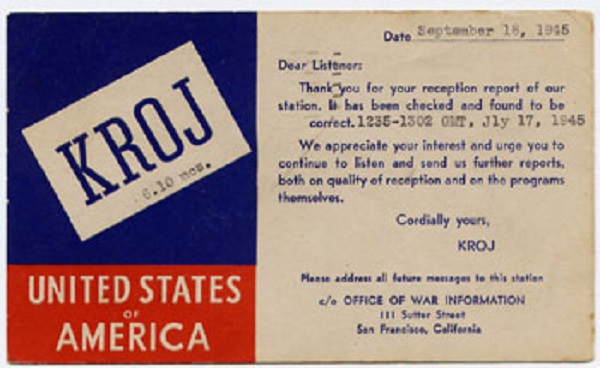 KROJ QSL card, VOA-OWI
KROJ QSL card, VOA-OWI
That is the story of an important international shortwave station that was on the air during the intense days of the decisive Pacific War. Programming from this station was beamed south to the Pacific and north to Alaska and it was made up of relays from OWI-VOA and also AFRS.
We take a look at the known information, admittedly a little sketchy, about this significant shortwave relay station, and we begin way back nearly 100 years ago.
Federal Telegraph
There was a maritime wireless station established on Ocean Beach in San Francisco near what became the southern end of the Golden Gate Bridge back in the year 1910. During the American involvement in World War I, this Morse Code wireless station was taken over by the Navy for naval communication, and in 1921, it was handed back to Federal Telegraph.
During the following year, another maritime station with updated electronic equipment was erected further south at a new location in the marshy areas of the inner harbor at Palo Alto. At the time, both of these stations were owned by the Federal Telegraph Company, which also owned a wireless equipment factory in the Palo Alto area, and both stations identified on the air in Morse Code as KFS. Over a period of six years, the maritime wireless communication service from the older Ocean Beach station was fully phased out in favor of the newer Palo Alto station.
Soon afterwards, the communication radio station at Palo Alto was sold to the Mackay Wireless & Cable Company, though the station still identified on air as KFS. That was its main call sign, and back in those days, every new channel in the shortwave spectrum was officially allocated a new three letter call sign. In the mid 1930s, most of the channel call signs from Palo Alto Radio were in the KW series, such as KWA, KWB, KWC, etc.
Immediately after Pearl Harbor, rapid moves were made in the United States to increase the number of shortwave transmitters on the air with international radio programming from a dozen up to about three dozen. In fact, on the West Coast at that time, there was only one regular station on the air with international shortwave programming; that was station KGEI, at Belmont, also south of San Francisco. It is true, special programs were broadcast from some of the communication transmitters operated by RCA (Radio Corporation of America) at Bolinas, but the scheduling was only occasional and spasmodic.
Quite quickly, additional shortwave transmitters were installed at various locations in California and brought into service as soon as possible to give international coverage into the Pacific and Asia, as well as to Australia and New Zealand.
Among these new stations back in the early days of the Pacific War were KWID and KWIX at Islais Creek, KRCA and KRCQ at Bolinas, and an additional unit at Belmont, KGEX. In addition, two new broadcasting units were made available at KFS, the Mackay maritime station at Palo Alto, and these identified on air with the four letter broadcast call signs, KROJ and KROU. A third unit, KROZ, was quickly commandeered for the surrender broadcasts in August 1945.
KROJ
The first of these new transmitters at Palo Alto was KROJ, and according to published information at the time, the transmitter was a 50 kW Press Wireless unit, manufactured in the United States, sent to England, and re-imported back into the United States.
However, another report states that the new KROJ was in reality an RCA unit, already available, that was quickly installed at Palo Alto and pressed into service. Notwithstanding these published reports, experienced radio personnel in the San Francisco area state that they consider the new shortwave service was transmitted from communication units already on the air at the Palo Alto station, and perhaps modified for broadcast usage.
Experienced international radio monitors in Australia and New Zealand who tuned in daily to the many shortwave stations in California during the Pacific War noted the strong signals from station KROJ and estimated the power output to be at 50 kW. The signal strength surely indicated that the power output of this strong new station could not be less than 20 kW, and certainly not at 100 kW.
Without ceremony or prior publicity, transmitter KROJ suddenly appeared on the shortwave bands with a relay of programming from VOA, the Voice of America and AFRS, the Armed Forces Radio Service. The first known monitoring of this new unit was in Australia in June 1943.
Just prior to Pearl Harbor, OWI, the Office of War Information in Washington, established a branch office in San Francisco. The location was 111 Sutter Street, the well known home for NBC around that era. West Coast programming for the VOA-OWI transmitters was produced in the Sutter Street studios, and also in studios established in two hotels on Nob Hill, Fairmont and Mark Hopkins.
The OWI-VOA office in Sutter Street sent me a copy of their official schedule for the California stations, effective Aug. 1, 1945, just a few days before the surrender broadcasts. This schedule included the programming from all of the California shortwave stations that were active in the VOA network at the time. These stations were KROJ and KROU, as well as KGEI and KGEX, KWID and KWIX, KCBA and KCBF, and KNBA/KNBI/KNBX, as well as the new Hawaiian station KRHO. (Over a period of time, we hope to look here at the history of all of the shortwave stations in the United States, including the California stations.)
This VOA schedule shows such familiar programs from the wartime era as "World News," "Concert Hall," "Our Marine Corp," "G.I. Jive" and "Hymns from Home". Commentaries from major sporting events were also included in their regular programming. This schedule shows only the English language programming, and none of the programming on the air in the foreign languages of Asia and the Pacific.
It is probable that the broadcast call signs for the relay transmitters at Palo Alto were derived from KRO. The call sign KRO had been in use previously with the RCA shortwave communication station at Kahuku on the island of Oahu, Hawaii and it was recycled into use at Palo Alto in early 1943. Hence, from communication KRO was derived the broadcast call signs KROJ, KROU and KROZ.
Footprint
The intended coverage areas for the transmissions from KROJ were the South Pacific, coastal Asia, New Guinea, Alaska and the Aleutians. Shortwave frequencies were chosen accordingly, to ensure propagation at the required distance and at the time of day in the reception areas.
The signal strength in the target areas was usually very good. In fact, an army officer serving in North Borneo stated on one occasion, as reported in a radio magazine in Australia, that he was hearing the broadcasts from KROJ via a local medium-wave (AM) station. It is probable that this off-air relay from KROJ in San Francisco was heard from an AM medium-wave station located on Labuan Island, North Borneo, that had been captured from the Japanese just a few days earlier.
A sister transmitter, KROU, suddenly appeared on the radio dial in April 1945, equally unheralded and unpublicized. Programming for this unit was also drawn from VOA and AFRS sources and beamed to similar areas as KROJ, north to Alaska and south to the Pacific. The planned scheduling for these two transmitters was announced ahead of time on air, and in radio magazines in the United States and Australia, and it was also sent to listeners in duplicated form.
At the time of the surrender broadcasts from Tokyo Bay in 1945, another Palo Alto transmitter suddenly joined the network, and this was identified as KROZ. This unit was already in service with communication traffic across the Pacific, it was stated, and because of the sudden requirements at the end of the Pacific War, apparently it was hurriedly given another broadcast call sign in the Palo Alto sequence and brought into service. Maybe this call sign with its very brief usage was even unofficial. Who knows?
Programming from KROZ was in parallel with KROJ. Station KROZ was on the air for a few days only, and at the most, just a week or two.
The last known program broadcasts from KROJ and KROU took place around November or December 1945. The war was over, and the two new and very large stations, VOA Delano and VOA Dixon, both in California, were already being phased into service. The temporary units at Palo Alto were no longer needed for broadcast service, and we would guess that they were quietly taken back into the regular communication service from Radio Palo Alto, station KFS.
The total time of on-air service from KROJ/KROU/KROZ was less than 1-1/2 years, and they vanished as they began, unheralded and unannounced.
NØUF has this on his website which I believe is part of what used to be posted on our website. He quotes "World Radio" June 1988.
June, 1988 Worldradio page 62
Sideswiper Net by Bob Shrader, W6BNB
The Society of Amateur Radio Operators (SARO), formed in 1937 in the San Francisco Bay Area, has recently reached back into the far distant past to come up with a "Sideswiper Net."
Old-timers may know what a sideswiper is, but for the younger members of the fraternity, it is a key that operates somewhat like a bug or an electronic keyer. On such keys - as you probably know - a push of the thumb produces a series of dots, and a push of the first finger produces a dash on a bug, or a series of dashes with an electronic keyer. But the sideswiper, or "cootie" key, makes a dash with either the thumb or first finger.
To make a dot, you just tap either side of the paddle(s) lightly. To make two dots, you tap first the left side and then the right side. To make an "S" you tap left-right-left, or you may make it by tapping right-left-right, and so on. For a "K" you can make a dash with the finger, a dot with the thumb, and the second dash with the finger; or again, you can reverse it and make a dash with the thumb, dot with the finger and dash with the thumb.
Sounds easy, doesn't it? Well it isn't. If you don't believe me, try it.
To try to send with a cootie key, you can use one of several types of keys. One of the easiest is to use an electronic key paddle that has a center lead and two outside leads (to the right and left contacts). By tying these two outside leads together, the center and outside leads make up a cootie key circuit. Or you can homebrew a short piece of hacksaw blade held at one end above a base board, that can be pushed against a contact to the right or against a contact to the left.
You can fashion your own paddle out of a piece of 1/8" 3-ply and glue or bolt it to the end of the hacksaw blade. You can also bolt two hand keys together, base-to-base, and fix them so the bases are at 90º from a wooden - or better yet, a heavy metal - base.
By far the simplest cootie key is made by tying the end of the vibrating end of a bug to its backstop with a rubber band so that the rod cannot move off of the backstop. Then with the thumb pushed to its stop, adjust the dot contact until it makes a solid electrical connection - and you have an excellent working sideswiper.
These keys were used 100 years ago by telegraphers, and later by the early-day radio operators. Around the '30s they began to disappear, and it is unusual to hear an old-timer pounding brass on a sidewinder any more. Once in a while you will hear one, probably on 40 or 80 M. They have a distinctive sound because it is extremely hard to make similar dots with both thumb and first finger, or similar dashes with thumb and finger. In most cases, a computer will not copy transmissions made by cootie key because of the "swing" of the sending. It tends to separate the men from the boys as operators. You usually can't cheat by copying cootie key operators with a computer; you have to be able to read the stuff by ear.
Actually, it requires many hours of practice on THE QUICK BROWN FOX JUMPED OVER THE LAZY DOGS BACK 1234567890.?, BT AR AS and SK before an operator dares to put his sending on the air. However, if you are one who enjoys a challenge, you will find your match in a sideswiper.
The SARO Sideswiper Net is on 3668.5 kHz at 9 a.m. Pacific Time on Tuesday mornings if you are interested and live in the central California area. If out of the area, you might try setting up a net of your own, if you can find any people crazy enough to check in with you.
It is a little painful to transmit with these keys. It is surprising how hard it is for an old-time bug or electronic key operator to train the part of his brain that the cootie key operates from. That old thumb just won't make dashes correctly!
I thought some would enjoy a bit of history. Nice memories from our departed cootie pioneers!
73
DR
Dave Ring N1EA
